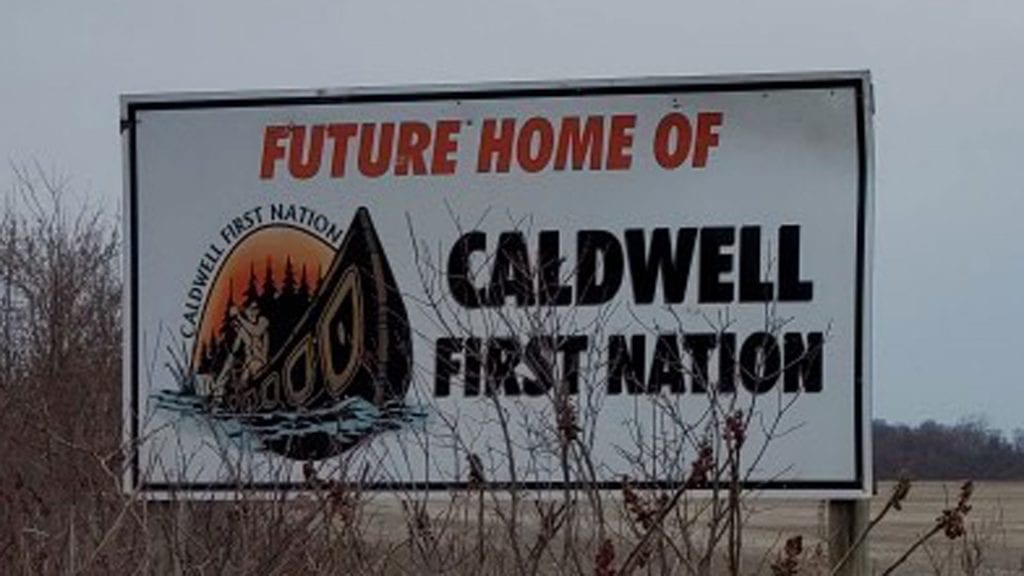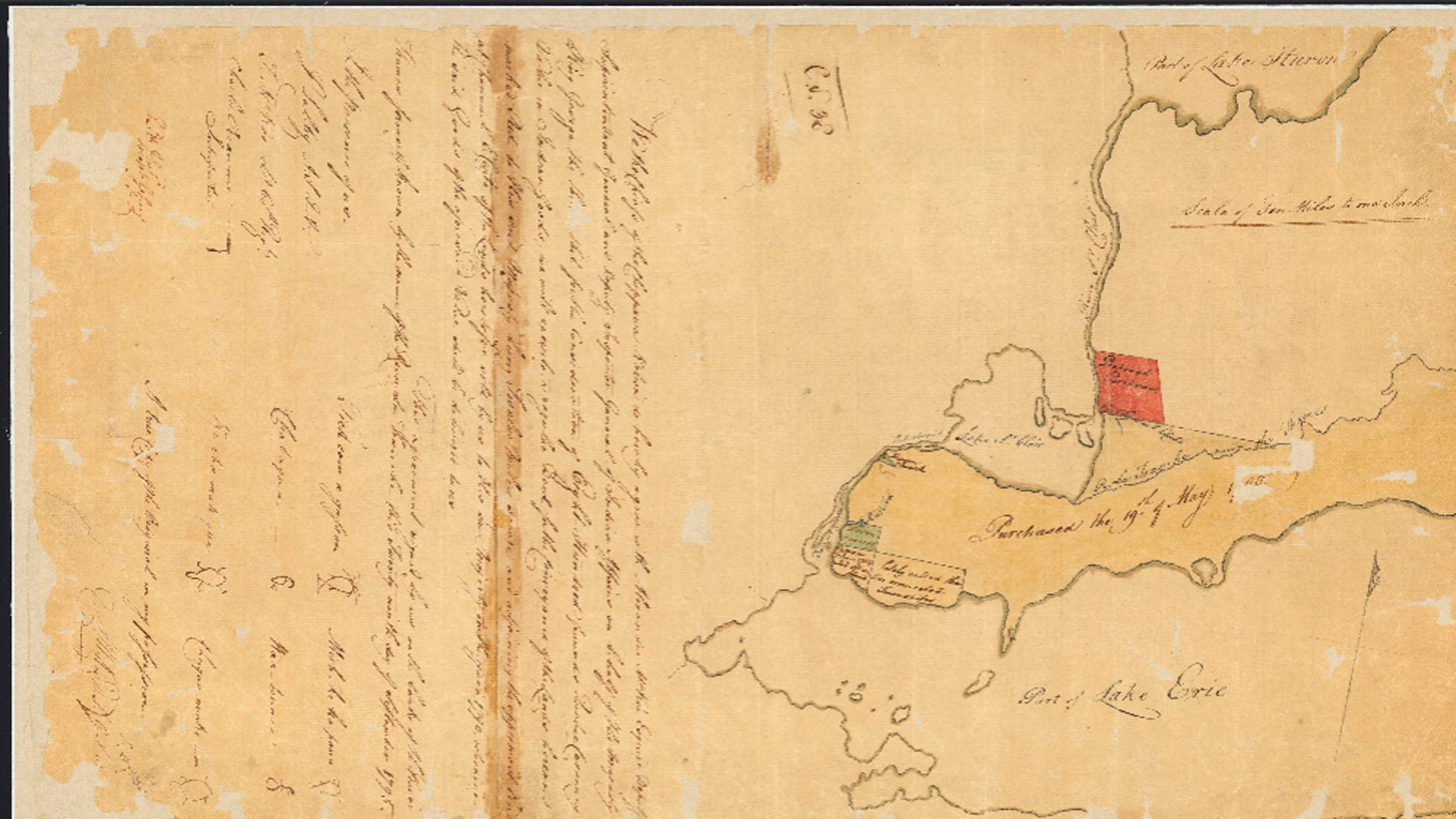
A sign announces the future home of the Caldwell First Nation outside Leamington, Ont., not far from their ancestral homeland of Point Pelee. Photo: Caldwell First Nation
One of the few First Nations in Canada without a reserve changed that this week, marking a major milestone in the small community’s 230-year fight for a homeland.
The Caldwell First Nation, previously known as the Chippewas of Point Pelee, announced on Monday that it secured reserve status for an 80-hectare property on the band’s traditional territory in what is now Leamington, Ont. on the north shore of Lake Erie.
“It was the heart of our ancestral home. Our people lived there. We fought. We protected it. We fought alongside the British as allies and we were promised that land,” said Caldwell Coun. Robyn Perkins in a phone interview.
“It’s finally nice to see that, after 230 years, the promise that was once made to our ancestors and to our warriors, it’s finally happened. It really brings healing to the community.”
Caldwell members lived much of that time displaced to reserves or towns nearby. But leadership never abandoned their claim to the territory in and around Point Pelee, the southernmost tip of the Canadian mainland, about 70 km southeast of Windsor, Ont.

Perkins said developing housing for community members who’d like to move back is a priority. She said the First Nation now possesses over 30 properties and 690 hectares in the area, purchased with $105-million land claim settlement reached with Canada in 2010.
The settlement didn’t include land. It gave the community a 30-year timeline to purchase properties at market value from willing sellers and put them through the federal Additions to Reserve (ATR) process.
The first property took nine years to make it through, while about a third of the band’s land holdings are either in the additions process or ready to go in. They can purchase up to 2,646 hectares.
“If we can get them through the ATR process, then I think we’re going to have a large urban reserve, and I think we’re going to hit that 30-year timeline,” said Perkins. “It’s unfortunate that it took 10 years to get through the first property through the process but we finally did it and it’s a huge success for our nation.”
Crown-Indigenous Relations Minister Carolyn Bennett called the creation of a land base for the displaced community “an important step” in the country’s history.
“Today we are able to right a historical wrong, advance reconciliation, and support the treaty relationship with Caldwell First Nation,” she said in a press release. “These lands will benefit your citizens and help you realize your vision for housing and economic development.”
Two centuries of persistence
The 360-member Caldwell First Nation lived within the lush, biodiverse marshlands of Point Pelee – which is now a national park – when European settlers and fur traders began filtering into the Great Lakes region.
In 1790, Alexander McKee negotiated a treaty with Anishinaabe (Chippewa, Odawa, Pottawatomie) and allied Huron leaders in Detroit. Through this treaty the Crown acquired title to a large swathe of land between the Thames River and Lake Erie, from what is now Windsor to London on the Ontario peninsula – including Point Pelee.
But the chiefs who lived there didn’t sign the treaty and didn’t benefit from it. They didn’t agree to cede anything.
Then during the War of 1812, the Point Pelee people fought as British allies alongside Capt. William Caldwell, when they became known as “Caldwell’s Indians.” As a result, the British promised them formal title to their homelands.

But the promise never materialized. In the decades after the war, the Caldwell people faced increasing pressure from settlers to vacate their homes. Very few families were left by the mid-1800s. Colonization displaced the rest.
They never gave up, however. Chief William Caldwell petitioned both Prime Minister John A. MacDonald and Duncan Campbell Scott to honour the Crown’s promise in the late 19th century, but no solution was reached.
In 1922, a small number of Caldwell members decided to occupy their traditional homeland at Point Pelee, which became a national park in 1918. They were met with fierce resistance from the RCMP and were again forced away. According to one historian, Scott himself called on the RCMP “to have the Indians dispersed.”
Still, the chiefs and the displaced band pressed on. They outlined their claim again in 1974 and filed a formal land claim under Canada’s specific land claims policy in 1987.
“We’ve suffered as a band without land. We haven’t been able to have a lot of the benefits that other communities do that have land, have that connectedness to the land, connectedness to each other,” said Nikki van Oirschot, Caldwell’s director of operations.
“We’ve just been completely disconnected from one another and from the land itself and that’s so integral to the people that we are.”
The federal government and the band reached an agreement in principle in 1998, but this too never came to fruition. They came back to the table in 2006 and inked a new settlement worth $105 million, which the community ratified.
Now, 10 years after the settlement, the Caldwell First Nation finally has the first part of its new urban Leamington reserve, which is about 17 km northwest of Point Pelee.
“Caldwell would like to acknowledge previous Chiefs and Councils for their hard work on finalizing the land claim settlement, acquiring lands, and moving forward with the application for Reserve status,” said Coun. Stan Scott in the press release. “Because of Caldwell’s persistence in our convictions, the next Seven Generations finally have a place to come home to.”
Council describes the nation’s vision for a progressive and prosperous community, a tourism hub that breaks the stereotypes sometimes associated with First Nations reserves, but it comes amid a contentious governance dispute happening within.
Good news amid a difficult dispute
The current administration spent much of the last two years embroiled in political conflict, with accusations of mismanagement coming from both sides.
Caldwell members twice elected Mary Duckworth as chief, but in that same span the council has twice deposed her.
Duckworth was first elected in 2018 then removed later that year. She ran in and won a by-election to fill the vacant post in 2019. Then in September 2020, council released a confidential memo to the membership explaining why it was again removing the chief.
The detailed memo was obtained by several media including APTN News. It included intimate details about the internal governance dispute, redacted documents, and correspondence that revealed several allegations on either side.
Duckworth struck back a month later by filing an application for judicial review in Federal Court. The lawsuit seeks a court order quashing the council’s decision to remove the chief and asks for her reinstatement.
Perkins declined to speak on the dispute, preferring to focus on the new land base, something generations of Caldwell leaders have sought. Duckworth also declined a request for comment.
The application remains before the court.









